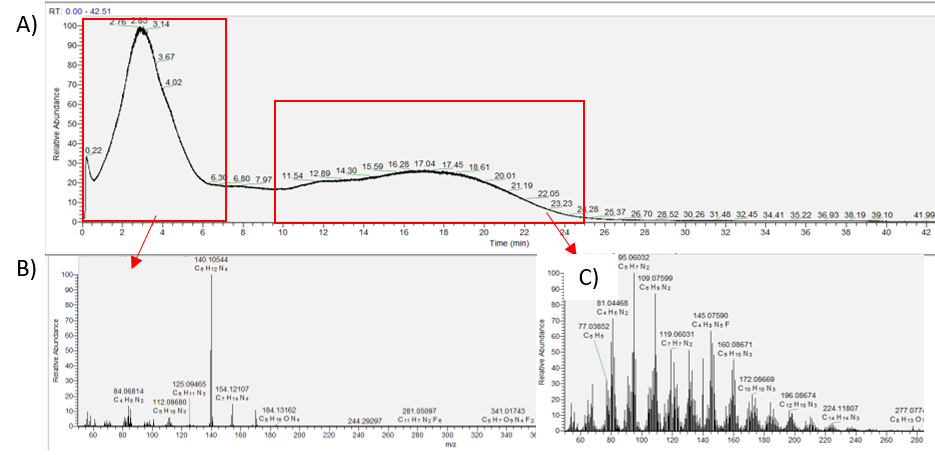Introduction
The organic molecular diversity present in extraterrestrial bodies such as asteroids and comets is of great interest for understanding the origin of life. However, the onboard analytical techniques are essentially low resolution mass spectrometry which, in view of the molecular diversity, quickly present limits both in the identification of compounds and in the comprehensive understanding of the composition of this type of sample. It is therefore interesting to question the interest to develop high resolution mass spectrometry for future space missions. In this context, the cosmorbitrap consortium is developing the spatialization of the Orbitrap. In addition, to optimize the identification of compounds within the samples to be analyzed, the coupling of such a technology to a gas chromatograph would also provide a gain in resolution and thus improve the characterization of the targeted samples.
In this perspective, a first development was carried out for a targeted analysis focusing on the detection of amino acids within analogues of soluble organic matter of meteorites [1] [2]. These molecules are particularly interesting because they have been detected in some meteorites and can be markers of the chemical evolution of the studied object [3]. Moreover, they could have played an important role in the homochirality observed on Earth [4]. In a second step, the same samples were analyzed by pyrolysis and thermal desorption, two sampling techniques usually used for in situ GC-MS analyses.
Materials and methods
Samples were analyzed on a GC-FT-Orbitrap-MS (Trace 1310 gas chromatograph with a Q-Exactive OrbitrapTM MS analyzer from Thermo Fisher Scientific).
Targeted amino acid analyses were performed on a chiral column: Chirasil-L-Val (Agilent). Pyrolysis and thermodesorption were performed on an RXi-5MS column (Restek). Evolved gas analyses (EGA) required the use of an inert column with an isothermal oven temperature.
For the analysis of the amino acid solution within the soluble organic meteorite analogues in GC-Orbitrap, a preliminary derivatization step was performed according to the method of Meinert and Meierhenrich [5].
The analogues were formed using the MICMOC device as described [6].
Preliminary results and conclusions
The optimization of the parameters and the realization of the calibration provide values of limit of detection and quantification as well as the sensitivity. A sensitivity in the order of 10-6 M is obtained .
Once optimized, the analysis of the amino acids within the analogues allows to observe about ten amino acids in full scan (see Fig. 1). By mass extractions about fifteen amino acids are identified. The use of GC-orbitrap for the targeted analysis of amino acids presents performances equivalent to those observed by GCxCG-TOFMS on the same samples, with higher detection and quantification limits.

Fig. 1. Full scan GC-orbitrap chromatogram of a derivatized residue for amino acids detection. Aminoacids are numbered as following : 1, Sarcosine; 2, D-Alanine; 3 : L-Alanine; 4, Glycine; 5, β-Alanine; 6, Methionine; 7, 2,3-DAPA.
In a second step, an EGA analysis of the same analogue was performed by thermodesorption (Fig. 2). The direct injection allows the rapid identification of molecules such as hexamethyletetramine (HMT) thanks to the high resolution of the mass spectrometer allowing to obtain the raw formula. Moreover, due to the possibility of obtaining these raw formulas a polymer of CHN composition is observed. To confirm these first results, an analysis via GC of the same sample allowed to confirm these first observations.

Fig. 2. EGA analysis of the non-derivatized residue. A) Chromatogram of the thermodesorption analysis. B) HMT derivatives. C) Mass spectrum of a CHN polymer.
These first data show that very high resolution mass spectrometry is an essential tool for the characterization of samples with a large molecular diversity. Coupled or not with a gas chromatograph, it allows to obtain raw formulas improving the identification of compounds in targeted analysis, and allowing to obtain information on the molecular content of a sample in direct analysis. Very high resolution mass spectrometry coupled or not to a GC is thus a promising technology for the future in situ analysis of interplanetary objects such as asteroids and comets.
Reference
[1] Muñoz Caro, G., Meierhenrich, U., Schutte, W. et al. Amino acids from ultraviolet irradiation of interstellar ice analogues. Nature, 2002, 416, 403–406
[2] G. Danger, F.-R. Orthous-Daunay, P. de Marcellus, P. Modica, V. Vuitton, F. Duvernay, L. Flandinet, L. Le Sergeant d’Hendecourt, R. Thissen, T. Chiavassa, Characterization of laboratory analogs of interstellar/cometary organic residues using very high resolution mass spectrometry, Geochimica et Cosmochimica Acta, 2013, Volume 118, 184-201
[3] Martins, Z., Modica, P., Zanda, B. and d'Hendecourt, L.L.S., The amino acid and hydrocarbon contents of the Paris meteorite: Insights into the most primitive CM chondrite. Meteorit Planet Sci, 2015, 50, 926-943.
[4] Iuliia Myrgorodska, Cornelia Meinert, Zita Martins, Louis le Sergeant d’Hendecourt, Uwe J. Meierhenrich. Quantitative enantioseparation of amino acids by comprehensive two-dimensional gas chromatography applied to non-terrestrial samples. Journal of Chromatography A, 2016, 1433, 131-136
[5] C. Meinert, U.J. Meierhenrich, Derivatization and multidimensional gas-chromatography resolution of a-alkyl and a-dialkyl amino acid enantiomers, ChemPlusChem, 2014, 79, 781-785
[6] L. d’Hendecourt and E. Dartois, Interstellar matrices: the chemical composition and evolution of interstellar ices as observed by ISO, Spectrochim. Acta A Mol. Biomol. Spectrosc., 2001, 57, 669–684



